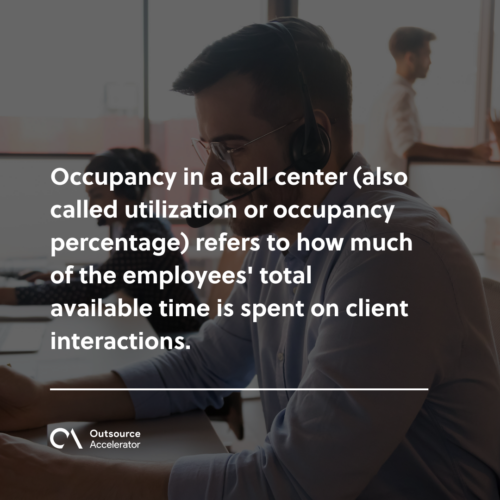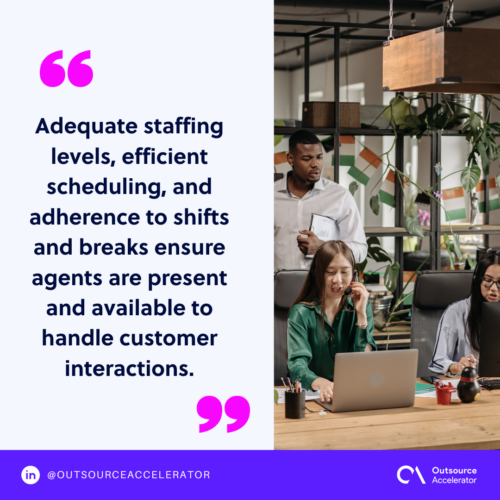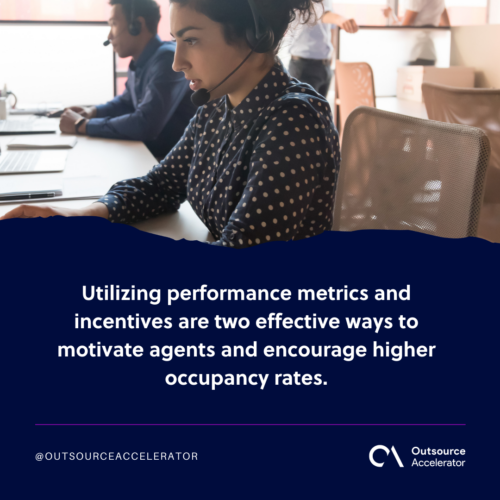An in-depth guide to occupancy in a call center KPI metric

Optimizing operational efficiency is critical in business process outsourcing companies. The occupancy rate is an important indicator that helps call center managers to assess productivity and resource allocation.
In this article, we’ll cover the importance of occupancy in a call center KPI metric, rate calculation, and factors affecting occupancy rate. We’ll also discuss effective workforce management strategies that may be used to improve occupancy rates and agent well-being.
Occupancy in a call center metric and its importance
Occupancy in a call center (also called utilization or occupancy percentage) refers to how much of the employees’ total available time is spent on client interactions.
Call center managers may use occupancy performance metrics to evaluate their personnel management tactics’ success.
A high occupancy rate shows that staff members interact with customers regularly, making the most use of their time. In contrast, low occupancy rates indicate the underutilization of resources and significant operational inefficiencies in call centers.
However, a strong occupancy rate depends on an agent’s peak performance and the level of quality in customer service delivered.

Calculation of occupancy in a call center metric
Average Handling Time (AHT) and Total Agents Time (TAT) are essential information in computing occupancy rate.
The average handle time describes the total amount of time spent on each client engagement, including:
- Speak time
- Wait time
- After-call activities
After handling account breaks, meetings, and other non-productive times. The total occupancy in a call center rate shows the total time agents are available to take client calls.
Here’s how the occupancy rate is calculated:
Occupancy Rate = (Total Handle Time / Total Agents Time) x 100
For example, if the total handle time is 3,500 minutes and the total staffed time is 4,000 minutes, the occupancy rate would be:
Occupancy Rate = (3,500 / 4,000) x 100 = 87.5%
Occupancy rate for different channels
It’s essential to comprehend the specifics of occupancy rates in agent calls, live chats, and emails to manage resources well and maximize performance in each channel.
Let’s explore how occupancy rates are monitored and assessed for various channels.
For agent calls
Occupancy rates in a call center evaluate the efficacy of agents’ participation in customer interactions. This measure excludes hold time and non-productive periods. It includes chat time, after-call tasks, and the time agents spend on actual calls.
A high agent call occupancy rate implies that agents are continually engaged and actively utilizing their time to respond to client inquiries properly, give help, and resolve difficulties.
It denotes a well-optimized call center operation in which operators are easily accessible and productive during consumer interactions.
Call centers may guarantee that their resources are properly employed by optimizing agent call occupancy rates—resulting in increased customer satisfaction—and higher overall efficiency.
For live chats
The percentage of time an agent is “occupied,” or actively chatting with a customer, is the occupancy rate for live chats. As agent calls, this statistic disregards downtime for higher chat response efficiency.
The occupancy in a call center rate sometimes measures agents’ ability to participate in live chat effectively. It measures how well agents can handle many inquiries while giving consumers the attention and help they need.
Contact centers must have high occupancy rates in this area to keep consumers’ waiting times at a minimum level while maximizing agent productivity.
Live chat occupancy optimization allows contact centers to:
- Improve customer service
- Decrease wait times
- Boost productivity
Moreover, load balancing methods like chat routing and agent skill-based assignment maintain high live chat utilization rates.
For emails
Email occupancy rates measure the time agents spend actively answering client emails. This occupancy in a call center rate evaluates activities like reading, writing, and replying to emails while removing non-productive hours.
Efficient email response time management is crucial for sustaining high occupancy rates in email support.
Agents must properly manage their time to respond to incoming emails. They should also offer fast and correct replies to customer inquiries and complaints.
As such, call centers use email management systems, pre-defined response templates, and prioritizing algorithms depending on the urgency and complexity of emails. This is to maximize email occupancy rates.
These tools also assist in streamlining email operations, enhancing response times, and guaranteeing that agents make the most of their time.
High email occupancy rates suggest that agents are committed to efficiently managing their email load while maintaining a high response rate.
Factors affecting occupancy rate
Various factors can affect the occupancy in a call center rate. Understanding these factors is crucial for call center managers to optimize occupancy rates. This also ensures efficient resource allocation in the firm.
Here are the significant factors that impact the occupancy rate in a call center environment.
Call volume
The call volume a call center agent handles directly influences its occupancy rate. As noted earlier, when call volumes are high, agents are more engaged and occupied—improving occupancy rates. This is because agents have more customer interactions, maximizing their utilization.
On the other hand, low call volumes can lead to idle time for agents, resulting in lower occupancy rates.
To manage call volumes effectively, call centers can implement forecasting techniques based on historical data and other factors to ensure appropriate staffing levels.
Agent availability
The availability of agents is a critical factor that impacts occupancy rates in a call center.
Adequate staffing levels, efficient scheduling, and adherence to shifts and breaks ensure agents are present and available to handle customer interactions.
When enough agents are available, the occupancy rate can be optimized as agents can consistently engage with customers.
Absenteeism or inadequate agent availability can negatively affect occupancy rates, reducing efficiency.

Agent skill and training
Call center agents’ skill level and training can also affect the occupancy in a call center.
Well-trained agents with the necessary knowledge and expertise can handle customer interactions more efficiently, resulting in higher occupancy rates. Agents that lack the required skills and training, on the other hand, may impede the critical call operation process.
As such, ongoing skill development initiatives can help keep agents updated and improve their performance. Comprehensive training programs must be implemented to equip agents with the required skills and product knowledge.
BPO companies must invest in agent training and development to enhance a call center’s ability to handle customer interactions swiftly. Doing so may improve occupancy rates.
Regular performance evaluations and feedback sessions must also be implemented. This will help identify areas for improvement and enable targeted training interventions accordingly.
Workforce management strategies to manage occupancy in a call center
Call centers should focus on effective workforce management strategies to maintain optimal agent availability. Implementing comprehensive scheduling systems and establishing clear attendance policies might help prevent this factor.
Call center managers may maximize the agent’s skills, match resources with customer demand, and maintain ideal occupancy levels by employing key strategies.
Here are the three key workforce management strategies for effectively managing your call center occupancy rates.
Forecasting and scheduling
As previously mentioned, accurately forecasting call volumes is essential for the proper scheduling of agents.
Call centers can predict the expected volume of incoming calls by analyzing historical data, seasonal trends, and other relevant factors.
This information enables managers to schedule the appropriate number of agents during peak and non-peak periods. It also helps maintain high occupancy rates by maximizing agent call-handling activities and minimizing idle time.
Real-time monitoring and adjustments
Continuous monitoring of call center operations allow managers to identify fluctuations in call volumes and occupancy rates in real-time.
By closely monitoring these metrics, managers can quickly respond to changes and make necessary adjustments.
For instance, managers can reallocate agents from non-essential tasks to handle customer interactions during high call volume periods.
Implementing routing strategies or adjusting staffing levels are real-time adjustments that help maintain optimal occupancy rates in a call center.
Performance metrics and incentives
Utilizing performance metrics and incentives are two effective ways to motivate agents and encourage higher occupancy rates.
Managers can create a sense of accountability and drive agent engagement by setting clear job specifications and measuring agent performance. Compensations, such as bonuses or recognition programs, can motivate agents to maximize their time utilization.
Team leaders can also create a productive and efficient culture by aligning performance metrics and incentives with occupancy goals.

Good occupancy rate in a call center increases agent well-being
High call-center occupancy rates are essential metrics for improving efficiency. But it is equally important to consider agents’ well-being.
While a high occupancy rate may significantly improve the overall call center operations, it can also lead to agent burnout and decreased job satisfaction.
By understanding the calculation methods, channel-specific considerations, and factors affecting occupancy rates, call center managers can:
- Effectively optimize the KPI metrics—balancing workload volume and employee well-being.
- Devise effective strategies to motivate agents and achieve ideal occupancy at a call center level.







 Independent
Independent




